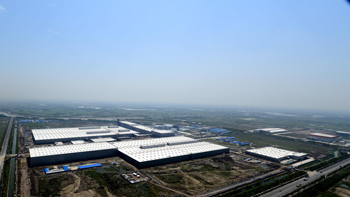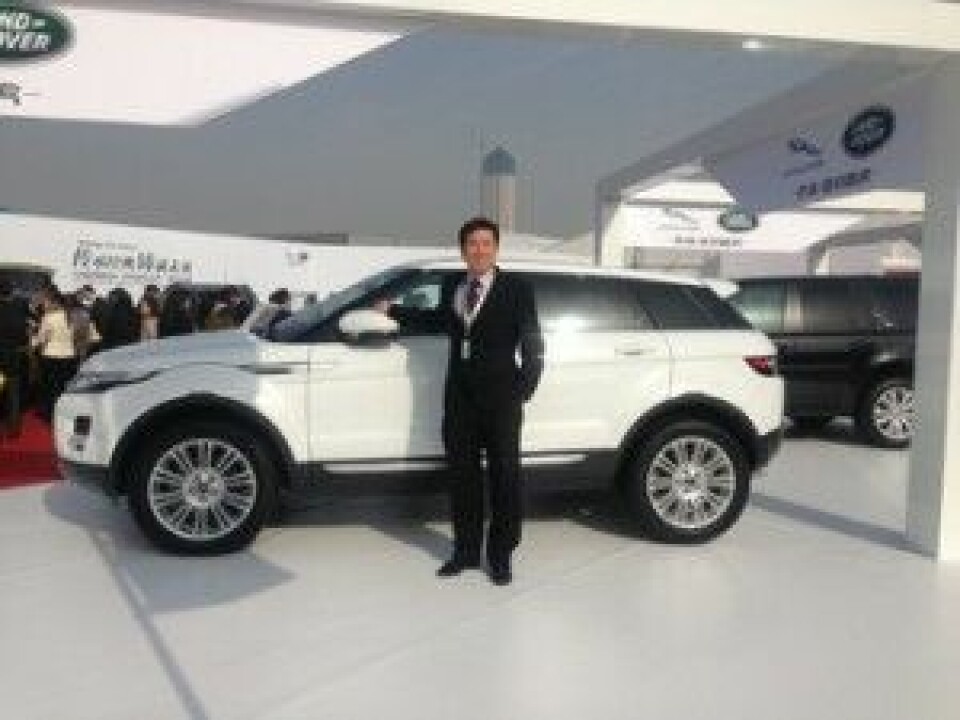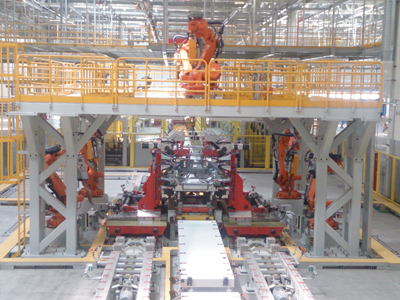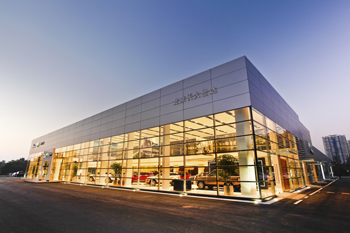Dawn of a new era
 With production set to start this year, JLR and Chery’s joint venture has learned vital lessons from its parent companies and is preparing to go out and navigate the supply chain on its own terms.
With production set to start this year, JLR and Chery’s joint venture has learned vital lessons from its parent companies and is preparing to go out and navigate the supply chain on its own terms.
It is an exciting time for the logistics team at Chery Jaguar Land Rover (CJLR), the 50:50 joint venture in China between Jaguar Land Rover and Chery Automobile. As the carmaker’s greenfield plant (pictured) enters its final construction stages – with production expected to start by year’s end – a supply chain network two years in the making is finally coming to life. Containers full of raw material and components are already arriving at the plant and contracts with several logistics providers are in place. According to Rui (Richard) Zhu, director of material planning and logistics (MP&L) planning, by this spring logistics operators will begin picking and sequencing material to build the first test batches.
It will be a complex system, with the 130,000-vehicle per year plant in Changshu, some 80km north of Shanghai, the consumption point of a supply chain stretching back to the UK and Europe, where a large portion of the material value of the first model is currently sourced. The plant will also have an exacting milkrun and pickup system for domestic suppliers, which will be managed – somewhat rarely for China – on ‘ex-works’ delivery terms. Material will feed into an in-plant pull system featuring some of the latest technology.

“We will be building premium cars, with a great deal of customer choice,” says Zhu, who has held logistics roles at GM and BMW joint ventures in China, and most recently at tier supplier Lear before joining CJLR November last year. “The local content and material flow will be important for our lead times and cash flow. We expect fast delivery and response in the supply chain.”
Building a system for the future
CJLR has naturally looked to its parents for influence over the design and management of its supply chain. As a department, MP&L planning is modelled mostly on JLR’s global MP&L department in the UK: it reports to manufacturing and integrates parts and vehicle order management with inbound, in-plant, vehicle and spare parts logistics. Purchasing of services is handled separately, but under MP&L guidance. JLR has also influenced the joint venture on operations including a lead logistics provider (LLP) model for outsourcing, key performance indicators (KPIs) and packaging standards. CJLR’s logistics division has close contact and interaction with JLR’s global MP&L in the UK, led by director David Dyke.
“Much of our approach is trying not to reinvent the wheel,” says senior manager of MP&L planning Alex Holland, who worked in logistics at PSA and JLR for 20 years, including on the launch of the Evoque, before joining CJLR in 2012.
“JLR has been building products a certain way for a long time and we have been able to take advantage of that with things like packaging designs, saving us a huge piece of work.”
However, CJLR is its own company, with conditions that make it as much a point of departure for JLR’s supply chain management as a continuation of its UK processes. While global standards apply to vehicles, variations can be glimpsed from the product strategy down to local trucking services. In contrast to JLR’s strategy in Europe, where for several years DHL has been LLP for much of its inbound supply chain and in-plant logistics, the joint venture has split up services between two LLPs – one for European-sourced material and another for China-sourced material and in-plant logistics.
Other differences come as the plant develops its own global system. Changshu is, with the exception of small knockdown kit operations, JLR’s first real adventure as a global manufacturer. “This is a massive opportunity for JLR and the lessons learned in setting up the China operation will carry forward into future programmes,” says Holland.
Entering such territory means that many processes are new and potentially defining for CJLR as well as JLR. “JLR owns half of us, but equally it is a supplier to us. That requires a different behaviour and mindset to what has been before,” says Holland. There are tough technical adaptations such as communicating order and material information across a long inbound pipeline, as well as determining local IT requirements. For example, the joint venture inherited a legacy JLR system for its bill of materials, which feeds into a brand new SAP system that links in-plant logistics with parts centres and quality monitoring. The new IT setup has been a real advantage, Holland says, but the challenge has been in creating interfaces to make JLR’s technology communicate with CJLR’s SAP system.
The general approach across the company’s logistics, says Zhu, has been to look first to JLR and its standard processes before benchmarking Chery and others in China. Zhu believes that this will ultimately benefit the parent companies too. “Even if we learn so much from JLR’s global logistics, our joint venture can also develop something new which could possibly teach a lot too, little by little,” he says. “The systems that we are developing will be there in the future.”
The need for long-range vision
Although CJLR has more to determine in the run-up to launch, including much of its outbound logistics, many plans are in place. To understand them, it is worth going through the material processes, beginning with the global content.
The first model will be a Land Rover SUV based on a UK platform; although the model has yet to be named, JLR China president Bob Grace recently told the Financial Times that its parent plant would be Halewood, near Liverpool, which builds the Range Rover Evoque and Land Rover Freelander. In either case, JLR production in the UK has a diverse supply chain, with many suppliers in west and central Europe, and so too will the China-built model.
The supply chain starts with UK and European supplies collected and then consolidated at a centre in Birmingham before exiting via the port of Felixstowe, on the English east coast. Holland admits it could make sense to establish a second centre for continental Europe depending on volumes and future localisation. Direct shipping for material from other global locations is also under consideration.
"We have to do what is right for CJLR as a business and some of those [decisions] are things our parents might not always like. Ultimately, we can justify and explain them, and they understand" - Alex Holland, Chery Jaguar Land Rover
From the UK, containers move to the port of Shanghai, where they are barged along the Yangtze River to the port of Changshu, close to CJLR’s plant. The journey takes a day, but is reliable and 20% cheaper than using road, according to Zhu. There is a deconsolidation warehouse just outside the factory gate where almost all imported and domestic material moves before call-offs to the line.
The delivery time is long – about nine weeks – but Zhu points out that CJLR has chosen a relatively low inventory approach, including ‘warehouse on the water’ planning. “We carry about three week’s safety stock, but only one week in the warehouse. The rest we control out into the pipeline,” he says. “There is one week’s stock on the barge and another week at the port of Shanghai.”[sam_ad id=6 codes='true']
To manage such a long supply chain, CJLR depends on an integrated order and material management process. The structure of MP&L, mirroring JLR, is helpful here, as it is responsible for the master scheduling and daily production plan. The order and forecast bank is shared with suppliers going out nine months, with monthly and weekly updates.
CJLR will also keep close control over this material by using a single LLP to manage the flow of European material from the consolidation centre in Birmingham all the way up to the plant gate in China (JLR manages the UK and EU collections). The provider – a Chinese company, but “one of the largest forwarders globally”, says Holland – will manage control towers that link shipping notices from JLR and provide visibility across both Europe and China.

While the processes and systems are in place and well planned, Holland admits the lengthy supply chain is a “massive challenge”. It makes it more difficult to respond to engineering changes, while the Chinese consumer is famously demanding, putting high pressure on speed and delivery accuracy. Furthermore, a considerable amount of JLR production in the UK (including at Halewood) is already running 24 hours per day on three shifts. Thus, the supplier production capacity that CJLR will share with JLR in Europe is already tight.
There are plans to manage the capacity and increase flexibility. For example, when the LLP proposed a seven-day expedited delivery from the UK, Zhu insisted on having an emergency three-day service including customs clearance.
Nevertheless, if demand is anywhere near as robust for local vehicles as it has been for JLR imports to China – sales grew 40% to 103,000 cars in the financial year to April compared to 2012-2013, while calendar year sales in China through April were up 44% – there will be limited room to catch up. “That puts a strain on us,” says Holland. “Things will get interesting when we need to test emergency freight routes and get material out of Europe.”
Local matters
The local supply chain has speed, cost and flexibility advantages over the European one. It will, however, take time for CJLR to establish more China-based content, at least for UK-derived Land Rover and Jaguar models. There has already been some important localisation for the Chinese supply base, Zhu points out. The nearby Qoros plant in Changshu, another Chery joint venture, could lead to more localisation, especially as that plant has a supplier park. In June, JLR’s director of purchasing also confirmed the carmaker would eventually build an engine plant in Changshu.
The logistics for domestic content will be managed by a second LLP. CJLR will provide production and delivery plans from which the provider will engineer routes, including direct deliveries and milkruns. As mentioned, most material moves to the plant warehouse, although there are also parts delivered directly to the gate based on sequence calls, including bumpers, tailgates, wheels and tyres.
Holland says there are currently no plans to use crossdock or consolidation centres within China, although that could change as local content increases.
The decision to use a second LLP for domestic material was intended to use both players’ expertise, says Holland. While it was tempting to have just one supplier, he recalls, in the end it was more appropriate to focus the supply chain on the strengths of each LLP. China’s logistics conditions, after all, demand a specific focus, whether enforcing truck and equipment standards (which vary greatly across the country), or understanding local regulations. As the OEM will also manage its logistics ex-works, taking responsibility from suppliers’ factories, having a provider with similar experience was thus also essential.
Why expect less in China?
Holland says that, although providers responded strongly to CJLR’s tenders, he and his colleagues saw many contrasts in what was on offer. “We went into one facility that was less than impressive, to put it mildly,” says Holland. “We were told ‘this is China, it can’t be perfect.’ Literally the next day we went to a different provider whose operations were pristine. ‘Why would you expect anything different?’ we were asked.”
CJLR eventually went with a large joint venture provider for its Chinese supply chain. While it has separated international from domestic, the carmaker has just one supplier for domestic inbound and in-plant logistics services so as to minimise complexity and possible friction.
Outsourcing in-plant logistics is common in China, including among large OEMs like Shanghai Volkswagen and Changan Ford. Zhu, however, who joined CJLR after the decision was made, had more experience with in-house plant logistics models at Jinbei GM and BMW Brilliance. For him, the experience of JLR in the UK, which also outsources in-plant logistics to DHL, offered useful insights.
“It was a new approach for me, but I am quite impressed. It means JLR is focused on manufacturing,” he says. “On the MP&L side, we change our focus to planning rather than operations, which is important. At the same time we have to define the right KPIs and systems for the LLPs so that we can properly manage the logistics.”
Kitting and technology
Within the plant, CJLR has set up advanced processes and technology to manage its material flow, including electronic kanban replenishment (a first for a JLR plant), a ‘pick to light’ system to support kitting, as well as RFID for body-in-white order management. The carmaker will also use returnable packaging for its local supply base, while global content arrives in expendable, recyclable cardboard.

Holland and Zhu say that MP&L planning has been particularly influential in determining the balance between kanban, andon, sequence deliveries and kitting. Compared to JLR in the UK, the Changshu plant will have higher levels of kitting – although nowhere near as much as the Qoros plant, which is near 100%.
“For JLR it has been traditional to have andon and sequence delivery, which has worked well,” says Zhu. “I have observed, for example, that the body storage area at UK plants is nearly empty, which means they are manufactured and delivered straight to the line. I am impressed by that high efficiency.”
As Changshu will eventually produce several models, planning ahead for kitting was important for saving line space and simplifying operations for assembly workers. “We need to save space along the assembly line so that we have space for parts and new models,” says Zhu.
Zhu adds that a high amount of kitting also requires considerable IT support to create sub-bills of material, which may also vary further by different vehicle models. “That needs to be supported by the mechanical department. Later, after we have tested the system more and are confident, we may look to add more locations for this,” he says.
Holland thinks CJLR has struck the right balance between kitting and other delivery methods, and will also benefit from a large marketplace area in the stampings, body-in-white, trim and final areas. Somewhat unusually, the space is large enough to accommodate kitting, kanban and sequencing operations. It can also fit these activities as new platforms are added. However, having a variety of operations in the marketplace means that accurate bills of process are doubly important.
“Especially when you are building both SUVs and sedans – which this plant eventually will – it’s key to have a close bill of process,” says Holland. “It gets tricky when the place to fit a bumper on one vehicle differs from another type, for example.”
Similar to JLR in the UK, the Changshu plant won’t have many automatic guided vehicles (AGVs), although it has a dolly system for the door line that moves along the production line with all the material needed for door assembly.
“It’s an advantage because you don’t have the maintenance costs of AGVs since you are powered by the door carriers,” says Holland.
Some better together, others on their own
Outbound logistics is among the pieces left to finalise, and Zhu and Holland cannot yet comment on CJLR’s outsourcing approach. The plant is well equipped, however: it has a dispatch yard for 2,000 vehicles, while the nearby port of Changshu has ro-ro facilities. The motorway infrastructure around Changshu is also well developed and surprisingly empty at off-peak hours.
Among the big questions is how CJLR will interact with JLR’s national sales company in China, which manages distribution and sales of imported vehicles from the UK, including the processing and final delivery from the ports of Tianjin, Shanghai and Guangzhou. Clearly there are opportunities: the company could barge vehicles from the terminal at Changshu to the east or ship by short-sea from Shanghai, maybe combined with imports, but Holland is cautious.
“Before we take vehicles by sea up to Tianjin or down to Guangzhou we have to make sure there would be no risk of delaying local vehicles with import processes, such as customs or quarantine,” he says. “We don’t want to add any lead time.”

Holland makes a similar point for last mile deliveries of the vehicles to dealers. He says that CJLR must make every effort to understand the needs of its dealers and customers in China. It is not altogether clear, for example, whether a dealership would have issues receiving trucks combined with imports and locally built vehicles.
Such an example is also a reminder of where carbon copies may not work between JLR and CJLR considering the different size and demands of the Chinese market. CJLR, after all, wants to have every advantage of being local as possible.
Zhu praises the information that David Dyke and the global MP&L department have given to his team so far, but he is also aware that CJLR is, by necessity, different. “Our business is drawn from people from JLR, as well as GM, Mazda, Daimler and BMW,” he explains, “but we have to enter under a CJLR culture, as one team.”
Holland agrees and admits disagreements are inevitable. “We have to do what is right for CJLR as a business and some of those [decisions] are things our parents might not always like,” he says. “Ultimately, we can justify and explain them, and they understand. We have had a tremendous interaction [with Chery and Jaguar Land Rover] and all learned a lot,” he concludes. “It has been a real challenge, but also hugely satisfying.”





